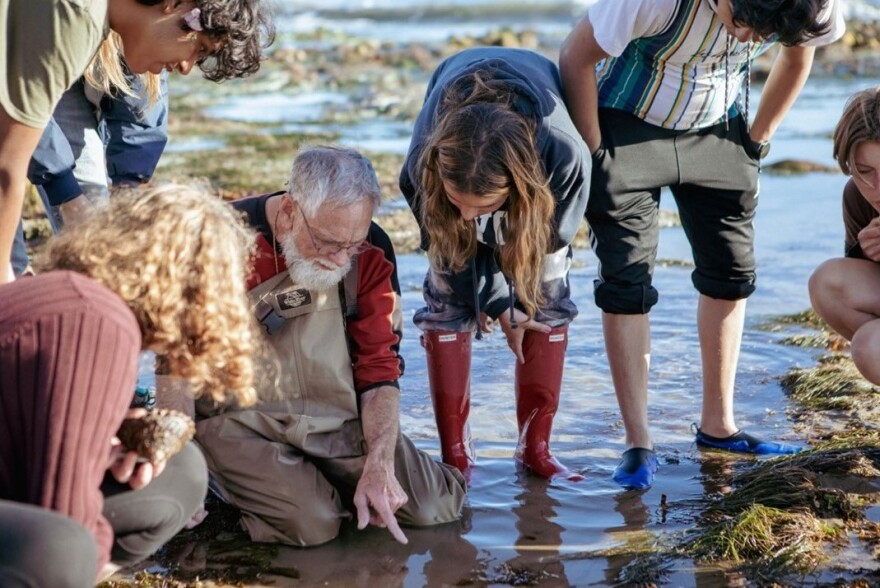A tiny species of clam never before seen alive has been discovered on a Central Coast beach. Using fossil records, local researchers identified the species and published a paper on their discovery, but questions remain about where it’s been hiding all these years.
Jeff Goddard is a research associate with UC Santa Barbara’s Marine Science Institute. He’s spent years in Santa Barbara’s rocky intertidal zones studying nudibranch sea slugs. He said he’s quite familiar with the wide variety of sea life in the local tide pools but in 2018, he got a major surprise.
“I turned this rock, and these two translucent white clams caught my eye. I had never seen them before,” Goddard said.
Goddard was at Naples Point a few miles from UCSB when he saw the pair of clams not more than half-an-inch in size.
“So, I dropped what I was doing and started taking close-up pictures,” he said.
Guessing this was a rare find, he didn’t disturb the clams. Instead, he sent photos to renowned mollusk expert Paul Valentich-Scott at the Santa Barbara Museum of Natural History. But without an actual specimen, it wasn’t possible to identify the species.

So, for the next several months, Goddard returned to Naples Point at low tide in search of the tiny clams.
“It wasn’t until about three months later on my ninth trip back there, and I turned a rock, and I found another one. It was like Eureka!,” Goddard said.
The challenge then became identifying the species. Valentich-Scott, who has studied clams since 1975, went to work in the lab.
“I was intrigued right off and so that started the hunt. My initial thought was that it was a new species,” Valentich-Scott said.
He began by scouring fossil records from the last 200-plus years. And finally, a sketch of a fossil unearthed in 1937 near the La Brea Tar Pits in Southern California looked like a match.
Valentich-Scott requested the actual fossil from the Natural History Museum of Los Angeles County. The pandemic slowed the whole process down, but when he got the fossil and compared it to the new specimen, he knew right away.
“I don’t think I’m ever 100% confident on any identification, but yes, I am very, very confident, certainly 95% confident that those are the same thing,” he said.
The fossil is from the Baldwin Hills Pleistocene that dates back thousands of years.
“They [paleontologists] think it’s between 100,000 and 120,000 years ago at this particular deposit, and that actually jibes really well with the La Brea Tar Pits which are just a couple of miles away from this deposit,” Valentich-Scott said.
This tiny species of clam somehow survived undetected all this time. He said no records exist of sightings by anyone in Southern California or anywhere else, until now.
“It’s never been documented alive until this discovery – until Jeff found them in 2018,” he said.
Valentich-Scott said it’s possible that the species is so rare and so small that it’s simply been overlooked, and he credits Jeff Goddard’s keen eye for finding it.

Goddard, with the UCSB Marine Science Institute, thinks a warming ocean also played a role. He said there’s a good chance that the clam rode the current northward during a recent marine heat wave.
“It may be one of these species that’s reflecting what’s going on with larger changes in ocean climate that relate directly to climate change,” he said.
Goddard said the clam species may be new to the Central Coast, but it’s been alive somewhere all these years — possibly Mexico.
“My hypothesis is that they are on the remote part of the coast to the south. The first place I would look are these giant boulder fields on the west coast of Baja,” he said.
Goddard said finding and identifying this forgotten species has been a remarkable journey for him as a scientist.
“You don’t often find living a species that has previously been known only from the fossil record. It’s sort of a living fossil,” he said.
Goddard and Valentich-Scott co-authored a paper on the discovery. It’s a hopeful story, they said, of a species thought to be long lost but found alive right here on a beach in Santa Barbara County. They encourage other scientists to continue the search up and down the coast.
You can find their paper online at ZooKeys.net





